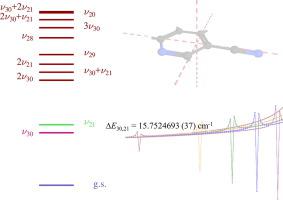当前位置:
X-MOL 学术
›
J. Mol. Spectrosc.
›
论文详情
Our official English website, www.x-mol.net, welcomes your
feedback! (Note: you will need to create a separate account there.)
An Analysis of the Rotational Ground State and Lowest-Energy Vibrationally-Excited Dyad of 3-Cyanopyridine: Low Symmetry Reveals Rich Complexity of Perturbations, Couplings, and Interstate Transitions
Journal of Molecular Spectroscopy ( IF 1.4 ) Pub Date : 2020-09-01 , DOI: 10.1016/j.jms.2020.111373 P. Matisha Dorman , Brian J. Esselman , R. Claude Woods , Robert J. McMahon
Journal of Molecular Spectroscopy ( IF 1.4 ) Pub Date : 2020-09-01 , DOI: 10.1016/j.jms.2020.111373 P. Matisha Dorman , Brian J. Esselman , R. Claude Woods , Robert J. McMahon

|
Abstract The rotational spectrum of 3-cyanopyridine from 130 to 360 GHz was recorded, and an analysis of the ground state and two lowest-energy excited vibrational states was completed. Almost 6700 new transitions were measured for the ground state and fit to a partial octic, distorted-rotor Hamiltonian with low error (σfit G a , G a J , F bc , F bc K , G b , G b J , and G b K . Numerous resonances, including those following a-type selection rules, ΔKa = 2 or ΔKa = 4, and b-type selection rules, ΔKa = 3 or ΔKa = 5, were observed and fit. For ν30 and ν21, the energy difference ( Δ E 30 , 21 = 15.7524693 (37) cm−1), both Coriolis coupling constants ( ζ 30 , 21 a = 0.8327 (9) and ζ 30 , 21 b = −0.0181 (3)), and vibration–rotation interaction constants were determined experimentally and compared to theoretical values determined computationally. Combined with the work on the vibrationally excited dyads of 4-cyanopyridine, phenyl isocyanide, benzonitrile, and phenylacetylene, the coupling in ν30 and ν21 provides an opportunity to compare the Coriolis interactions of these analogous mono-substituted aromatic molecules in unusual detail. Additionally, this work improves the ground-state rotational constants and centrifugal distortion constants of 3-cyanopyridine and provides the fundamental constants needed to support an astronomical search for 3-cyanopyridine in the interstellar medium.
中文翻译:

3-氰基吡啶的旋转基态和最低能量振动激发二元组分析:低对称性揭示了扰动、耦合和州际跃迁的丰富复杂性
摘要 记录了130~360 GHz 3-氰基吡啶的旋转光谱,完成了基态和两个最低能量激发态的分析。为基态测量了近 6700 个新的跃迁,并拟合到具有低误差的部分 octic、扭曲转子哈密顿量(σfit G a 、 G a J 、 F bc 、 F bc K 、 G b 、 G b J 和 G b K . 观察并拟合了许多共振,包括遵循 a 型选择规则 ΔKa = 2 或 ΔKa = 4 和 b 型选择规则 ΔKa = 3 或 ΔKa = 5 的共振。对于 ν30 和 ν21,能量差( Δ E 30 , 21 = 15.7524693 (37) cm−1),科里奥利耦合常数 ( ζ 30 , 21 a = 0.8327 (9) 和 ζ 30 , 21 b = -0.0181 (3)),以及振动-旋转相互作用常数通过实验确定并与计算确定的理论值进行比较。结合对 4-氰基吡啶、苯基异氰化物、苯甲腈和苯乙炔的振动激发二元组的研究,ν30 和 ν21 中的耦合提供了一个机会,以不同寻常的细节比较这些类似的单取代芳香分子的科里奥利相互作用。此外,这项工作改进了 3-氰基吡啶的基态旋转常数和离心畸变常数,并提供了支持在星际介质中对 3-氰基吡啶进行天文搜索所需的基本常数。
更新日期:2020-09-01
中文翻译:

3-氰基吡啶的旋转基态和最低能量振动激发二元组分析:低对称性揭示了扰动、耦合和州际跃迁的丰富复杂性
摘要 记录了130~360 GHz 3-氰基吡啶的旋转光谱,完成了基态和两个最低能量激发态的分析。为基态测量了近 6700 个新的跃迁,并拟合到具有低误差的部分 octic、扭曲转子哈密顿量(σfit G a 、 G a J 、 F bc 、 F bc K 、 G b 、 G b J 和 G b K . 观察并拟合了许多共振,包括遵循 a 型选择规则 ΔKa = 2 或 ΔKa = 4 和 b 型选择规则 ΔKa = 3 或 ΔKa = 5 的共振。对于 ν30 和 ν21,能量差( Δ E 30 , 21 = 15.7524693 (37) cm−1),科里奥利耦合常数 ( ζ 30 , 21 a = 0.8327 (9) 和 ζ 30 , 21 b = -0.0181 (3)),以及振动-旋转相互作用常数通过实验确定并与计算确定的理论值进行比较。结合对 4-氰基吡啶、苯基异氰化物、苯甲腈和苯乙炔的振动激发二元组的研究,ν30 和 ν21 中的耦合提供了一个机会,以不同寻常的细节比较这些类似的单取代芳香分子的科里奥利相互作用。此外,这项工作改进了 3-氰基吡啶的基态旋转常数和离心畸变常数,并提供了支持在星际介质中对 3-氰基吡啶进行天文搜索所需的基本常数。











































 京公网安备 11010802027423号
京公网安备 11010802027423号